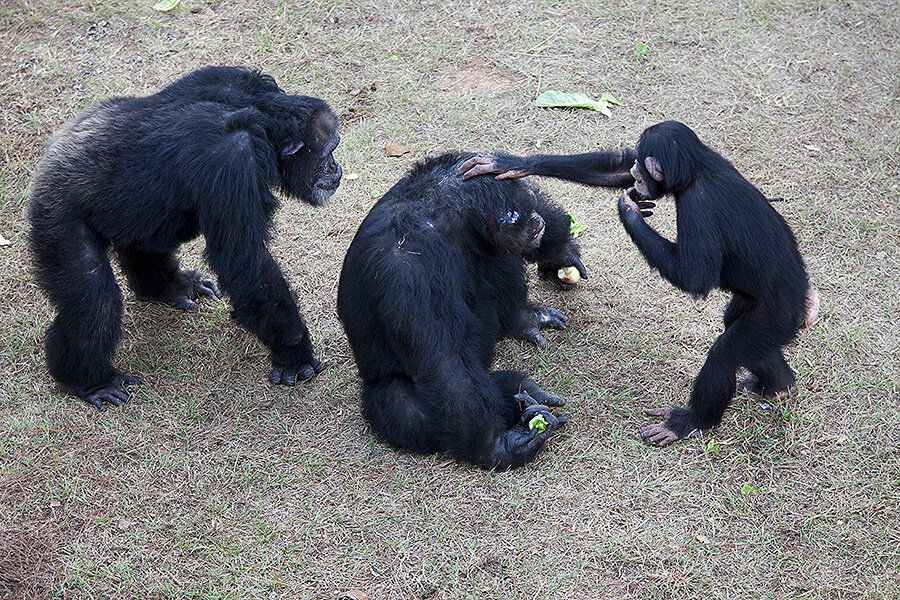Why fewer chimps are being used as guinea pigs
Loading...
What do the United States and Gabon have in common?
They're the world's only countries that permit medical testing on chimpanzees, for one. But many scientists and animal advocates agree, whether with enthusiasm or reluctance, that the US will soon be leaving that list.
On Wednesday, the National Institutes of Health (NIH) announced it would retire 50 chimpanzees, the last veterans of a once-robust chimp research program. The chimps will gradually be sent to a sanctuary in Keithville, Louisiana, as spots open up: right now, room exists for only 25.
The last 50, kept at facilities in Texas and New Mexico, were held onto as "reserves" after the NIH retired more than 300 in 2013. That decision followed an NIH-commissioned report from the Institute of Medicine, which encouraged strictly limiting the use of chimps in medical research.
Animal rights advocates, including those who argue that governments should recognize their "personhood," have spent decades fighting the perception that it's acceptable to subject humans' closest relatives to experiments and conditions that would never be approved for humans. But the NIH's decision appears to be based on just as much science, and practicality, as justice: Not a single scientist has applied to use the NIH's chimps for two and a half years.
"We have moved on from the time when research on chimpanzees was considered essential," NIH director Francis Collins told NBC.
But federal research money will still be used for experiments with other primates.
"If you’re a scientist, a chimp is really a sort of last resort," the NIH's Harold Watson, who directed chimp research, explained to The Washington Post in 2011.
Drug makers and other researchers are increasingly turning away from chimps in favor of other primates, such as rhesus monkeys, but also an array of new technologies, which can be not only more accurate but also cheaper than using chimps for research. Release & Restitution, an advocacy group opposed to chimp testing, recommends that studies swap primates for tissue and cell research, or long-term human studies that are observational, not experimental.
The similarities that led many scientists to see chimps as ideal human analogs – they are genetically and behaviorally similar but without legal rights – are exactly what drives many people to protest chimp research, and the underlying assumption that the apes belong to a different ethical category.
Research has shown that chimps can recognize themselves in mirrors and even mourn the dead, human-like behaviors that make many wary about subjecting them to small confines, unnatural environments, medical testing, and trauma.
Research has suggested that testing chimps can lead to PTSD, although their study focused on just two animals. The authors wrote in the Journal of Trauma and Dissociation:
Given what we know about human trauma, depression, anxiety, and other emotional disorders, and given that chimpanzees share most of our cognitive, emotional, and social needs, then chimpanzees’ ability to suffer as the result of their institutionalized use in biomedical research and testing is likely to lead to myriad symptoms which in humans would warrant psychiatric diagnosis and intervention.
What's now a trend could one day become the law. In 2011, then-Rep. Roscoe G. Bartlett (R) of Maryland and Sen. Maria Cantwell (D) of Washington reintroduced the Great Ape Protection and Cost Savings Act, hoping to ban invasive research on monkeys like chimps, gorillas, and orangutans. The bill, however, died in Congress.
Some medical researchers say that it's not yet safe, for humans anyway, to take chimps out of the lab.
Some diseases such as hepatitis are thought to infect chimps but few or no other animals; scientists credit chimp studies with helping them develop vaccines against the disease, according to The Washington Post.
"It's important to keep chimps available for diseases we haven’t seen yet, future ‘Hot Zone’ agents we can only speculate about," NIH researcher Robert Purcell told The Washington Post in 2011.






